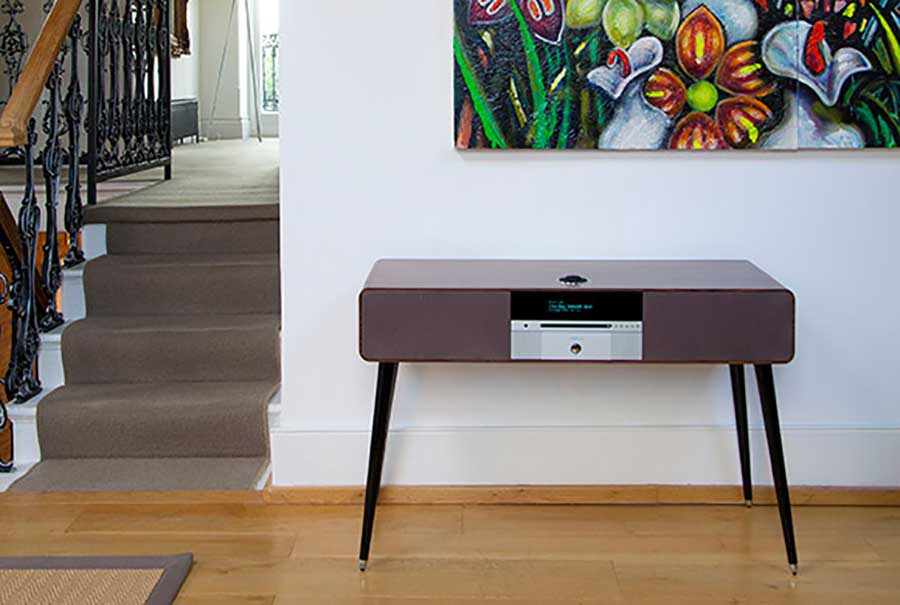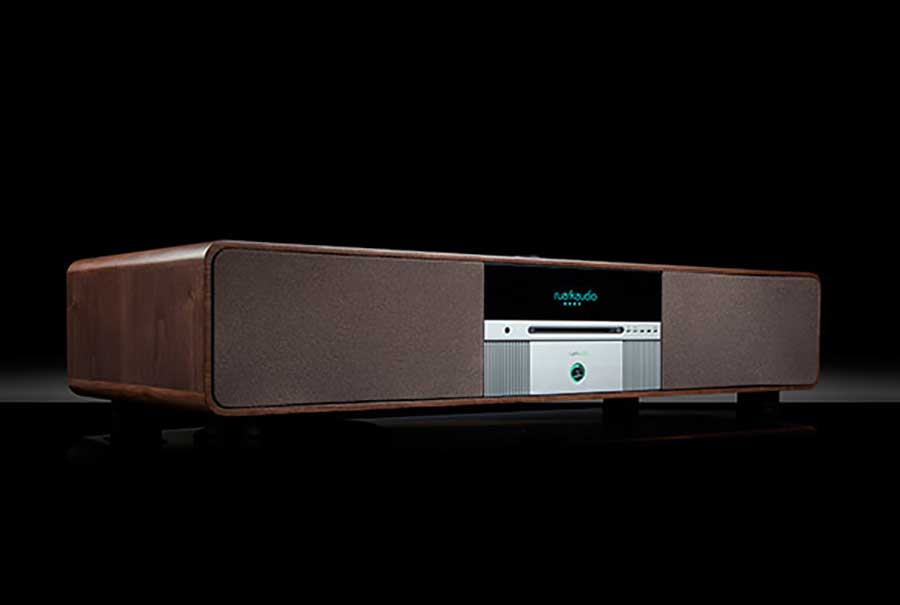Many of us of a certain age will remember the radiogram, now Ruark bring it bang up to date with their R7 Radiogram costing £2000. John Scott gets a bit nostalgic in what is a bit of a departure for Hifi Pig.
I have been fascinated by music and the things that make music for literally as long as I can remember. My earliest musical memories centre around a 1950s HMV radiogram that took pride of place in the corner of our living room. At this point, readers born after 1970 may require some explanation as to what a radiogram actually is. The radiogram combined a record player – we didn’t call them turntables back then – with a radio (we didn’t call those tuners yet either). The record player and radio were housed in a solid wooden cabinet containing a speaker, or if you were lucky a pair of speakers, and usually a little built in cupboard to store your record collection. The radiogram was as much a piece of furniture as a functional item and was built for the ages – ours still lives in my mother’s house.
That radiogram entertained and educated me. I moved from Pinky and Perky records (if you don’t know, look them up) and a series of orange vinyl 7 inch records that played at 78 rpm and contained nursery rhymes and children’s stories, to cherry picking from my elder sister’s record collection. She was principally a Cliff Richard fan and I didn’t share that enthusiasm but The Last Time by The Rolling Stones, Yeah, Yeah by Georgie Fame, Here Comes The Night by Lulu and Cathy’s Clown by The Everley Brothers were given regular plays. The radio was something to be played with rather than played; the 4 bandwidths of VHF, Long Wave, Medium Wave and Short Wave could individually be coaxed into making a variety of interesting noises by twiddling the tuning knob but musically speaking there was little there to interest me. That would all change in 1967 through, when BBC Radio 1 took to the airwaves.
The radiogram fell out of fashion by the end of the 1960s; replaced by the music centre, which typically added a cassette deck to the turntable/radio combo, and the increasing popularity of separate systems for those who really took their hifi seriously. Tons of teak, mahogany, valves and Garrard turntables were consigned to the scrap heap – just not in our house. Fashions often come full circle and if you have visited the furniture department of your local department store recently you will have noticed that 1950s furniture is bang on trend; all sexily-curved sofas and spindly-legged tables. And if your local department store is the same as mine, a Ruark R7 radiogram sitting prettily in amongst them and looking perfectly at home.
Unboxing and Appearance
Like the radiograms of yore, the R7 is very much a piece of furniture and is also solidly built; the unit’s 30 kg weight is testament to the quality of its walnut, aluminium and glass construction. The unit arrived well packet inside a sturdy cardboard container. A cardboard box is a cardboard box but the external design featuring the Ruark logo and a breakdown of the R7s features give a sense of the quality of the quality of the product within. Opening the box, the R7 and its component parts were so well packed that I was already dreading the repacking that I would have to do when the time came to return the product. Luckily when the time came, that actually turned out to be pretty straightforward.
The R7 itself is cozily snuggled in a large cotton drawstring bag – very useful for protecting the walnut cabinet work if you need to put the unit into temporary storage. A second box contains the power supply and a third the legs, remote control, FM aerial and various other accoutrements. Slipping the R7 out of its little sleeping bag, I was immediately struck by the quality of its cabinet work – it really is superb, not just on the obvious visible surfaces but also on the base of the unit where the subwoofer lives. The R7 can be used as a freestanding unit on its elegant spindle legs. Alternatively, is can sit on top of a sideboard or AV cabinet supported on 4 screw-in “pucks”. Aesthetically, my preference was for the freestanding spindly-legged option but the presence of a Christmas tree in the room meant that space was at a premium so, after a short test period using the legs, the sideboard option was the one I went for.
Setup, Operation and Sound
You would expect an all-in-one unit like a radiogram to be simplicity itself to set up and the R7 does not disappoint on that account. The circular, almost hemispherical, remote control is intuitive to use and in combination with the bright and clear front panel display, I very quickly entered my wifi password and connected the R7 to the audio files on my NAS and to Internet radio via my router. It is possible to scroll through your network audio library using the remote and the display but if you gave a large library this quickly becomes tedious. This is not a particular criticism of the R7 however – this process on the R7 is no more or less tedious than on any other product that offers on-screen library navigation. Fortunately, as the R7 is UPnP compliant, I was able to use my NAS’s library management app on my iPad to more easily navigate my collection.
Safe in the knowledge that my digital library was under control, I decided to start my R7 listening experience with the FM/DAB radio options. I have never owned a radio that relied on a ribbon aerial and found the results to be anywhere near satisfactory. Unsurprisingly, the R7 was no different. I went through the usual farce ballet of positioning the ribbon in unlikely and impractical configurations in order to get a signal that was as stable and static-free as possible. Why anyone would want to do this when there is a perfectly acceptable substitute available in the form of Internet radio is beyond me. I can say that because radio is not a particularly important source for me. If it is for you, however, then connecting the R7 to an external FM/DAB aerial ought to see you right in that department.
Moving on to the CD player, I mirrored the R7’s retro-but-modern feel with Don’t Be Afraid, the recent album from country singer Tami Neilson, which also has a Fifties style with an up to date twist. The R7 suited the album’s production perfectly; twangy baritone guitars were detailed and resonant; Tami’s vocals were rendered with clarity but with a degree of warmth. The overall sound just made me want to settle down with a glass of red wine and wallow in the album from start to finish.
The R7 retained these qualities when I moved on to some choices from my digital library. The R7 can be warm and comfortable like an old pair of slippers but it is also adaptable. When asked to summon up the crisp, cold air and glacially-sculpted landscapes of Sibilius’ second symphony, it was still capable of painting an appropriate sonic picture. Once again I found myself simply settling back and letting the music take me away. It would be unrealistic to expect the R7 to have a massive soundstage and it doesn’t, but it does do okay for its size. I threw a lot of different styles of music at the R7; given the time of year, a lot of different styles of Christmas music in particular, and time and again the word I kept coming back to was comfortable. The R7 isn’t the last word in tonal accuracy, it won’t knock you off your feet in the way that it coveys pace, detail and rhythm but it does offer an easy and seductive listen. Playing Haitian Divorce from Steely Dan’s album The Royal Scam, I still got caught up in the intricacies of the instrumentation but I wasn’t able to pull the music apart and follow Dean Parks’ guitar lines or Bernard Purdie’s hi hat throughout the song in quite the same way as I normally can with my usual hifi set up.
I have not previously had any use for Bluetooth in an audio system but I discovered that the R7’s USB port was capable of powering my Amazon Dot and once I had paired that to the R7 via Bluetooth, there was great fun to be had by asking Alexa to play Radio 2 or a 1960’s Christmas playlist. She even came up with the goods when I asked her to: “play the song that goes ‘Poor old Johnny Ray’”. Okay, so this was straying away from hifi quality but for a bit of casual listening and a bit of fun it was perfectly acceptable.
Conclusion
The Ruark R7 is a versatile, stylish and very well-built unit bringing together a CD player, network player, FM/DAB and Internet radio and Bluetooth connectivity. It is never going to outperform a well-matched set of separate components but that’s not really the point and so if you feel this is the kind of thing for you it comes highly recommended. The R7 brings something unique to your home. If you decide that you need one in your life then nothing else will do.
AT A GLANCE 
Build Quality: First-class craftsmanship, oozing quality
Sound Quality: Not the last word in Hifi at the price but a highly engaging and enjoyable listen
Value For Money: Purely in sound terms you can make £2000 go a lot further, but the R7 is much more than just a piece of audio equipment
Pros:
Versatile and easy to use
Killer looks (if Fifties-inspired design is your thing)
Exceptional build quality
Cons:
Fifties-inspired design is not for everyone
If sound quality is your top priority, you can do better for the money
Price: £2000
John Scott
Specifications
DAB, DAB+ and FM Tuner with RDS
Ultra black, high contrast fluorescent display
Dual aerial inputs allow for separate DAB and FM aerial feeds
Comprehensive Internet Radio functionality
Slot loading CD player plays CD-Audio and MP3 music disks
Full Wi-Fi capability allows wireless networking and music streaming
Bluetooth with aptX allows CD quality direct streaming with compatible devices
Charge-port for charging smartphones and tablet computers
2 × 5.5” dual concentric stereo drive
1 × 8” long throw subwoofer drive
160 watts nominal power output
Switchable digital and analogue auxiliary inputs
Adjustable treble and bass settings
Enhanced 3D sound processing
Stereo headphone output
Dimensions (without legs): H175 × W1000 × D400mm
Dimensions (on legs): H650 × W1000 × D400mm
Weight: 30kg
Supplied with spindle legs for free standing mode or puck feet for mounting R7 on existing sideboard or AV cabinet
Optional TV mount
Rich walnut veneer cabinet and black lacquer legs



















































































































































































































You must be logged in to leave a reply.